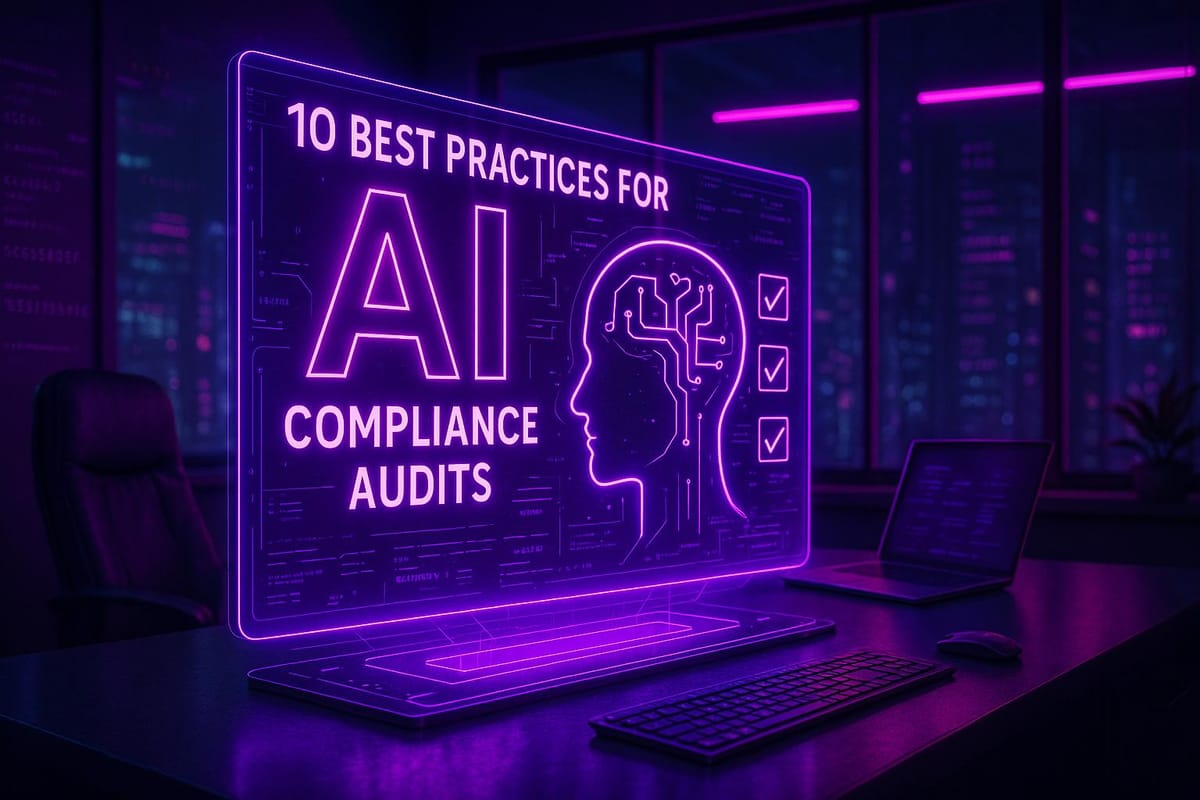10 Best Practices for AI Compliance Audits
Explore essential practices for conducting AI compliance audits, ensuring your systems uphold legal and ethical standards.

AI compliance audits are critical for ensuring your systems operate within legal, ethical, and regulatory boundaries. Here’s a quick rundown of the 10 best practices to follow:
- Build a Cross-Functional Team: Include data scientists, legal experts, business stakeholders, and risk specialists to cover all aspects of the audit.
- Define Clear Scope and Objectives: Focus on high-risk systems and align with relevant regulations like FTC, EEOC, or state-specific laws.
- Map AI Systems and Data Flows: Create an inventory of AI tools and track their data sources, processing steps, and outputs.
- Review Data Governance: Ensure data collection, storage, and usage meet compliance standards and maintain data quality.
- Assess Model Explainability: Document how AI models work, their inputs, and decision-making logic for transparency.
- Test for Bias: Check for disparities in outcomes across demographic groups and address any discriminatory patterns.
- Evaluate Human Oversight: Ensure humans can intervene in AI decisions, especially in sensitive applications like hiring or lending.
- Review Privacy and Security: Verify that personal data is handled securely and in compliance with laws like GDPR or CCPA.
- Maintain Documentation: Keep detailed records of AI system operations, decisions, and updates to demonstrate compliance.
- Set Up Continuous Monitoring: Regularly track key metrics like accuracy and bias, and schedule periodic audits.
These steps help mitigate risks, improve AI performance, and ensure compliance with evolving regulations. By implementing these practices, you can safeguard your organization while building trust with stakeholders.
Establishing AI Auditing Standards and Compliance Measures | Exclusive Lesson
1. Build a Cross-Functional Audit Team
To conduct an effective AI audit, you need a team with a mix of expertise. No single person can address all the technical, legal, and business aspects involved. A well-rounded group ensures every critical angle of your AI system is thoroughly evaluated.
Here are the four key roles your team should include:
- Data scientist or AI engineer: Responsible for assessing technical aspects like model performance and understanding how the system works under the hood.
- Legal or compliance professional: Focuses on ensuring the system complies with federal guidelines from agencies like the FTC and EEOC, as well as emerging state-level AI laws.
- Business stakeholder: Evaluates how the system affects operations and customers, while also having the authority to act on recommendations.
- Risk management or internal audit specialist: Oversees the audit process, ensures documentation is complete, and provides an objective perspective.
Sometimes, outside help is necessary. If your team lacks expertise in a specific area - like natural language processing (NLP) or regulations for industries like healthcare or finance - bringing in a consultant can fill those gaps. For example, an NLP expert can help if you're auditing a chatbot, or a specialized legal advisor can assist with industry-specific compliance.
The team leader plays a crucial role in keeping the audit focused and organized. They don’t need to be the most technical person but should have enough understanding of AI to facilitate meaningful discussions and ensure progress.
Clear Roles and Responsibilities
Define each team member’s responsibilities from the start. For example:
- The technical expert handles model validation and data quality checks.
- The legal professional manages compliance and risk evaluation.
- The business stakeholder examines the operational and customer impact.
- The audit specialist ensures the process is thorough and well-documented.
Time Commitment and Diversity
AI audits can take weeks, depending on the system's complexity. Each team member must fully commit to meetings, documentation reviews, and their specific assessments. Part-time involvement often results in incomplete work and overlooked issues.
Diversity within the team is also critical. If your AI system serves different regions, include members familiar with those markets. Similarly, if the system affects multiple business units, ensure representation from all impacted areas. This approach helps uncover blind spots and provides a more comprehensive review.
Finally, tailor the team to suit the system being audited. For example, include HR experts for hiring algorithms or cybersecurity specialists for fraud detection tools. Every audit has unique requirements, and your team should reflect those needs.
2. Define Clear Audit Scope and Objectives
Before diving into an audit of your AI systems, it’s crucial to clearly define what you’re auditing and why. Without well-drawn boundaries and measurable objectives, you risk overlooking critical issues or wasting resources on less important areas.
Start by pinpointing which AI systems fall under your audit’s scope. Focus on the systems that carry the highest risks - those influencing decisions like hiring, lending, or customer service. For example, a financial institution should prioritize auditing its credit scoring algorithm over a tool that classifies internal documents.
Geography plays a significant role too. If your AI operates across multiple states, you’ll need to account for local regulations and compliance standards in each jurisdiction. Map out where your systems are deployed and identify the laws and guidelines that apply in those areas.
Next, outline the regulatory framework you’ll follow. This might include federal and industry-specific regulations like the EEOC, FTC, HIPAA, or FCRA. For instance, healthcare-related AI must align with HIPAA, while financial systems may need to comply with the Fair Credit Reporting Act.
Your objectives should be precise and measurable. Instead of a broad aim like "ensuring compliance", set specific goals. For example, verify that your hiring algorithm doesn’t discriminate based on protected characteristics or confirm that your chatbot transparently informs users it’s AI-driven. These clearly defined objectives help your team stay focused and provide a way to measure the audit’s success.
Once objectives are set, assess risks to fine-tune your scope. High-risk systems, such as loan approval algorithms or resume screening tools, often require deeper scrutiny because they directly impact individuals. In contrast, lower-risk systems like inventory management tools may need less attention. Factor in both the likelihood of issues and their potential impact on your business and customers. Document these findings to avoid scope creep.
Finally, put everything in writing. Detail the specific AI systems under review, the regulations they must meet, geographic considerations, and your audit objectives. Set realistic timelines based on the complexity of the systems and the availability of necessary data. If critical documentation is missing, either adjust your scope or delay the audit until access is granted. Having a clear, written plan ensures everyone stays aligned and focused.
3. Map AI Systems and Data Flows
Once you've clearly defined the scope of your audit, the next step is to map out your AI systems and their data flows. This process helps you identify where compliance risks might be hiding. By creating a detailed inventory of your AI systems and their data pathways, you can ensure no potential compliance issues slip through the cracks.
Start by cataloging every AI system your organization uses. This could include tools like chatbots, recommendation engines, email filters, fraud detection systems, or predictive maintenance platforms. For each system, document its purpose, who uses it, when it was deployed, and its role in your business. Make sure your inventory aligns with your audit's objectives so high-risk systems are addressed first. Don't forget to include both in-house systems and third-party tools you license. For example, if you're using Salesforce Einstein for lead scoring or Microsoft's AI Builder for document processing, these should be part of your inventory.
For each system, track the flow of data from start to finish. Where does the data come from? How is it collected, stored, and accessed? Where does it end up? Pay special attention to data involving personal, health, or financial information, as these often come with strict regulatory requirements.
Identify and list your data collection methods, whether through web forms, APIs, file uploads, or even scraping. Understanding these methods is key to spotting compliance gaps.
Next, document any preprocessing steps your data goes through. For instance, if your system fills in missing demographic information based on zip codes, this could unintentionally introduce bias - something financial institutions need to be particularly cautious about when it comes to fair lending practices.
Outline where data is stored, whether on-premises, in the cloud, or in a hybrid setup. Include details about security measures like encryption, access controls, and retention policies. This information will be essential when demonstrating compliance with data protection laws.
If you share data with external vendors or partners, document these arrangements carefully. Specify what data is being shared, why, and under what contractual terms. This is especially critical for industries like healthcare, which must comply with HIPAA, or financial services handling sensitive customer data.
To make this process clearer, create visual data flow diagrams. These diagrams should illustrate how data enters the system, gets processed, and results in decisions or outputs. Visual aids like these not only help you spot compliance issues but also make it easier for auditors to understand your system's architecture.
Keep your inventory up to date, reflecting any changes in systems or data flows. Be mindful of state-specific regulations, such as California's CCPA or Virginia's CDPA, which may apply depending on where your data subjects are located.
Finally, document system interdependencies and look for any unauthorized AI deployments, often referred to as "shadow AI." These unapproved systems can pose serious compliance risks because they typically lack proper governance, documentation, and security measures. Your audit should actively seek out these hidden systems and bring them under formal oversight.
This thorough mapping process lays the groundwork for a deeper dive into data governance in the next phase.
4. Review Data Governance and Quality Controls
Once you've mapped out your data flows in detail, the next step is ensuring that your governance measures keep this data both reliable and compliant. It's crucial to evaluate your data governance practices and quality controls to minimize compliance risks and maintain trust in your AI systems.
Verify data collection practices. Make sure your data collection methods have secured the necessary consents and comply with legal requirements. Double-check that your forms include clear privacy notices and that users understand what data you're collecting and why.
Set clear data quality standards. Data accuracy, completeness, and timeliness should meet predefined benchmarks. Weak governance can result in compliance violations, biased outcomes, and flawed AI decisions that could harm your business.
Review data retention and deletion policies. Regulations often require personal data to be deleted after a specific period or when it's no longer needed. Ensure your automated deletion processes work as intended and that no data is retained longer than legally allowed.
Assess data access controls and user permissions. Implement role-based access controls to minimize unnecessary data exposure. Keep a record of privileged accounts and ensure they are actively monitored and audited.
Examine data lineage tracking capabilities. You should be able to trace data from its origin all the way to its use in AI models. This is especially important during regulatory reviews or investigations.
Audit vendor data management practices. Check that your vendors adhere to data processing agreements that align with your standards for quality and security.
Inspect data classification and labeling systems. Confirm that data is consistently classified and handled according to its type - whether personal, sensitive, or public.
Evaluate data quality monitoring and remediation processes. Ensure automated systems are in place to flag data quality issues. Also, verify that there are clear escalation paths to address and resolve these problems quickly, especially when they could impact compliance or AI performance.
Review governance documentation and training. Make sure your staff fully understands their responsibilities under your governance policies and applicable regulations. Check training records and test whether employees can properly identify and handle various types of data.
Strong governance isn't just about compliance - it lays the groundwork for trustworthy AI systems. By ensuring consistent data quality and adhering to regulations, you'll build a solid foundation for reliable AI operations. Up next: examining model explainability and transparency to strengthen your compliance framework even further.
5. Assess Model Explainability and Transparency
To earn trust, it's crucial that your models can clearly explain how they make decisions. This means documenting the model's architecture, the data it uses as inputs, and the logic behind its decisions. Following established standards like the CLeAR Framework can help ensure your models are not only explainable but also easy to compare with others.
Good documentation does more than just satisfy technical requirements - it plays a key role in internal audits and regulatory reviews. It also bridges the gap for nontechnical stakeholders, making it easier for them to grasp how decisions are reached. By aligning your documentation practices with recognized frameworks, you create a strong foundation for AI systems that are both transparent and accountable.
For help integrating these standards into your compliance processes, NAITIVE AI Consulting Agency provides expert consulting services. Learn more at NAITIVE AI Consulting Agency.
6. Test for Algorithmic Bias and Discrimination
Thoroughly evaluate AI systems to identify any performance differences across key demographic groups. Bias can creep in at multiple stages - whether during data collection, model training, or deployment. That’s why a detailed review is critical to remain in compliance with regulations. Bias testing serves as a crucial step in a broader AI compliance audit, complementing earlier efforts like data mapping and quality checks.
This process builds on prior work in data governance and model transparency, aiming to create an AI system that meets compliance standards. Focus on identifying protected characteristics relevant to your application - such as race, gender, age, religion, national origin, or disability status. Monitoring the outcomes for these groups ensures that your AI system does not lead to discriminatory results.
When disparities are discovered, address them by refining your data collection processes or adjusting how the model is trained. Keep meticulous records of your testing methods, metrics, findings, and the steps you take to address issues. Regulatory guidelines like the EU AI Act require detailed documentation, particularly for high-risk AI systems.
Beyond addressing bias, organizations must also ensure that these testing practices align with data protection laws, such as GDPR, especially when handling sensitive demographic data.
As your AI system evolves, conduct regular reviews and retests to maintain fairness over time.
7. Evaluate Human Oversight and Control Mechanisms
In the realm of AI compliance audits, human oversight stands as a critical safeguard to prevent AI errors from leading to unintended consequences. A thorough audit should assess whether humans retain meaningful control over AI systems, especially in high-stakes situations where automated decisions carry significant implications for individuals or organizations. This human layer complements technical safeguards, ensuring decisions made by AI remain fair and contextually appropriate.
Start by identifying decision points where human involvement is either necessary or possible. Clearly document who has the authority to override AI-generated recommendations, under what conditions they can step in, and how quickly they are able to act. This is particularly important in sensitive areas like hiring, lending, healthcare, or criminal justice, where decisions hold substantial weight.
Assess whether supervisors are equipped with enough context to make informed decisions. Often, AI outputs lack transparency, leaving oversight personnel to approve or reject decisions without fully understanding the rationale. Ensure that supervisors are provided with clear explanations detailing how the AI arrived at its conclusions, the data that influenced its decision, and any alternative options considered.
Examine the training and skills of oversight staff. Those responsible for monitoring AI systems must have the technical knowledge to grasp the limitations of AI, recognize potential failure modes, and know when to challenge automated outputs. Evaluate whether your organization offers ongoing training to keep staff updated on system changes, regulatory shifts, and emerging practices in AI oversight.
Review escalation procedures for unexpected scenarios. Check if your organization has well-defined protocols for situations where AI confidence levels fall below acceptable thresholds, when different AI models produce conflicting results, or when external conditions call for human judgment. These procedures are essential for addressing edge cases and avoiding errors.
Analyze recent intervention cases to test the effectiveness of human oversight. Look at instances where humans overrode AI decisions - evaluate the response times, the quality of the decisions made, and whether the override mechanisms worked as intended. Patterns of recurring issues could point to deeper flaws in either the AI system or the oversight process.
Define accountability structures clearly. Establish who is responsible for AI-driven decisions, including liability for errors, how performance is tracked and reported, and what consequences exist for lapses in oversight. Ensure that oversight mechanisms are scalable to match the growth of AI systems, even as the volume of decisions increases. Consistent and scalable oversight, paired with clear accountability, is essential to maintaining compliance with legal and ethical standards.
8. Review Privacy, Security, and Regulatory Compliance
AI systems come with privacy and security risks that could leave organizations vulnerable to legal and financial penalties. To mitigate these risks, a thorough audit should assess how well your AI systems protect personal data and adhere to regulatory requirements. This process goes beyond simple checklists - it's about ensuring your privacy and security measures work effectively in practice.
Start by defining how your systems handle personal data. Map out the types of personal information your AI systems collect, process, and store. Pay close attention to sensitive data like biometrics, health records, financial details, or information about minors. Your audit should confirm that your systems can locate and retrieve personal data tied to an individual within required timeframes.
Limit data collection to what's absolutely necessary. Document the types of data your systems use and eliminate anything that's not essential to their purpose. This reduces privacy risks. Ensure your systems automatically delete data after set retention periods and can honor deletion requests without affecting functionality.
Review consent mechanisms and transparency efforts. Make sure consent forms are written in plain language, allow users to withdraw consent easily, and accurately reflect how data is used. Your systems must respect user preferences and provide clear, upfront information about data collection practices.
Evaluate the security controls protecting your AI systems and data. Check that encryption standards are in place for data both at rest and in transit. Enforce strict access controls to limit who can view or modify AI models and training data. Implement monitoring tools to detect unusual access patterns or potential breaches. Pay special attention to AI-specific risks like model theft, adversarial attacks, or data poisoning.
Run tabletop exercises to simulate privacy breaches or security incidents. These simulations should cover legal notification requirements, steps to contain and resolve incidents, and communication strategies for affected individuals and regulators. Make sure your procedures address mandatory reporting obligations triggered by a breach.
Don’t overlook external partners. Many organizations rely on cloud providers, AI vendors, or external data processors, which can introduce additional compliance challenges. Review contracts to ensure they include data protection clauses, verify vendors' security practices, and confirm you have visibility into how third parties handle your data. These checks are essential for identifying and addressing compliance gaps.
Document findings and create remediation plans with clear timelines and responsibilities. Prioritize issues based on their potential impact and the likelihood of regulatory scrutiny. For example, gaps related to consumer rights under laws like the CCPA may need immediate attention, while less urgent security improvements can be scheduled over time. Include regular progress reviews and update risk assessments as you implement changes.
Stay ahead of evolving AI regulations. Keep an eye on new state and local requirements, as well as proposed legislation and industry-specific rules that could affect your compliance obligations. Incorporate these developments into your audit and remediation plans to ensure you're always prepared.
9. Maintain Complete Documentation and Audit Trails
Keeping thorough documentation and audit trails is a cornerstone of AI compliance. These records act as a continuous thread, capturing every compliance-related activity. Without a detailed log of how your AI systems operate, adapt, and make decisions, proving compliance during regulatory reviews - or pinpointing the causes of unexpected outcomes - becomes a daunting task.
"Audit trails are essential for understanding the behavioral and decision-making processes of AI systems. They provide clarity on how decisions are made, fostering trust among users and stakeholders." - T3 Consultants
Start by documenting every input: its source, how it was collected, preprocessing steps, and any transformations applied. Include quality checks, data cleaning, or filtering processes to ensure transparency and reliability.
Track every stage of model development and deployment. Keep records of model iterations, hyperparameters, training datasets, validation results, and performance metrics. When models are updated or retrained, note the reasons for the changes, who authorized them, and the testing conducted before deployment. This level of detail ensures you can reproduce earlier versions if needed and provides accountability for each update.
Log decision outcomes along with justifications. Record not only the results your AI generates but also the reasoning behind them. Include confidence scores, feature importance rankings, and any other explanatory details the model provides. For decisions with higher stakes, document human review notes and any overrides, creating a clear history of how decisions were made. Automating this logging process ensures consistency and protects the integrity of your records.
Secure automated logging systems to capture critical data like timestamps, user actions, and performance metrics. Using cryptographic methods to protect these logs ensures they remain untampered, even during system failures or high-traffic periods.
Track all human interventions and system access events. Whether it’s a manual override, configuration change, or security event, log every instance with details on who was involved, when it occurred, and why. These records not only prevent unauthorized access but also provide valuable context for understanding how external factors may influence AI performance. Organize these logs in searchable repositories for easy retrieval during audits.
Make your documentation repositories accessible and well-structured. A record is only helpful if it can be quickly located. Use indexing and search tools - filterable by date, user ID, model version, or decision type - and establish clear naming conventions and folder structures that cater to both technical teams and compliance officers.
Define retention policies for your documentation. Different types of records may have varying storage requirements depending on regulatory and business needs. For instance, high-risk decisions might require permanent storage, while routine logs could be archived after a certain period. Balancing compliance with storage costs is key to effective documentation management.
Leverage audit trails for ongoing improvement. Regularly analyze your logs to spot trends, detect anomalies, and address potential issues before they escalate. Periodic reviews can uncover signs of model drift or bias, allowing you to make timely adjustments that improve the system's reliability.
"As regulatory scrutiny and compliance obligations grow, detailed audit trails for AI applications become critical. These trails deliver governance, risk mitigation, and accountability throughout the AI lifecycle." - T3 Consultants
"Audit logs are a valuable asset in this regard. In fact, simply informing employees that audit logs exist has the potential to enhance compliance with policies governing AI use." - Aisling Murray, Credal.ai
Finally, test your logging systems regularly under time constraints to ensure they are complete and functional. Simulate retrieval scenarios to identify and fix any gaps before auditors or regulators do.
For expert guidance on building robust documentation and audit trail systems, reach out to NAITIVE AI Consulting Agency for tailored solutions in AI compliance.
10. Set Up Continuous Monitoring and Regular Audits
Once you’ve established solid documentation and audit trails, the next step is implementing continuous monitoring. This step is crucial to maintain compliance as your AI systems grow and adapt over time.
Using automated monitoring tools can make this process much more efficient. These tools help track critical KPIs like model accuracy and bias metrics, allowing you to catch deviations early and address potential compliance issues before they escalate.
When it comes to audits, the frequency should align with the complexity and risk level of your AI system. A mix of internal assessments and external reviews ensures a well-rounded approach to compliance:
"AI audits should be conducted on a regular basis to ensure ongoing compliance and performance. Audits should be scheduled periodically - such as quarterly or annually - depending on the complexity and risk level of the AI system." - dotnitron.com
For a thorough review, use both in-house expertise and external auditors. If you need specialized advice, you can reach out to NAITIVE AI Consulting Agency for expert support.
Comparison Table
The method used for audits can have a big impact on expenses. Studies show that manual AI compliance processes tend to be resource-intensive and expensive, whereas automated solutions are designed to help cut those costs.
Here's a quick look at how manual and automated audit processes compare in terms of costs:
| Aspect | Manual Audit Process | Automated Audit Process |
|---|---|---|
| Cost | High due to significant resource demands | Lower costs achieved through automation |
Conclusion
Following these ten best practices for AI compliance audits is more than just meeting regulatory requirements - it’s a smart move for businesses navigating today’s AI-driven world. By getting ahead of the curve, companies can align with emerging regulations while ensuring their AI systems are developed and deployed responsibly. In a constantly shifting business environment, these strategies are key to staying competitive and achieving long-term success.
Integrating AI into existing workflows requires more than just technical know-how; it demands continuous oversight to ensure smooth, secure, and compliant operations. Regular monitoring and adjustments are crucial to maintaining compliance over time.
As regulations around AI become stricter, having strong audit practices in place is no longer optional - it’s essential. Businesses that invest in building robust compliance frameworks now will be better equipped to adapt to new rules without disrupting operations or compromising their AI initiatives.
For organizations looking to implement these practices effectively, NAITIVE AI Consulting Agency offers the expertise needed to navigate the complexities of AI compliance. Their experience in creating advanced AI solutions includes the compliance frameworks necessary for sustainable adoption.
In today’s landscape, reactive compliance won’t cut it. Companies that take a proactive approach to these audit practices will not only meet regulatory expectations but also pave the way for responsible AI innovation that adds real business value.
FAQs
What steps should I take to build an effective AI compliance audit team?
To create a strong AI compliance audit team, start by bringing together a mix of professionals with expertise in legal, technical, and compliance fields. This combination helps cover all angles when it comes to spotting risks and adhering to regulations.
Assign specific roles and responsibilities to each member, ensuring everyone knows their part. It's also important to prioritize continuous learning so the team stays updated on the latest AI advancements and regulatory changes. Promote collaboration across disciplines to build a deeper understanding of AI-related risks and governance. With a united and well-informed team, you'll be better prepared to tackle compliance challenges and address potential problems effectively.
What should I do if I find bias in my AI systems during an audit?
If you uncover bias in your AI systems during an audit, the first step is to dig into the data and algorithms to pinpoint where the issue stems from. Pay close attention to how the data was gathered, processed, and used to train the model - these are often the main culprits behind bias.
After identifying the root causes, take steps to address them. This might mean retraining the model with datasets that better represent a diverse range of perspectives, using algorithms designed to promote fairness, or tweaking decision-making processes to minimize bias. Keep in mind that bias isn’t a one-time fix. Regular audits and ongoing monitoring are crucial to identifying and resolving new biases as they arise, helping your AI systems stay fair and aligned with ethical standards over time.
Why is continuous monitoring important for AI compliance, and how often should audits be performed?
Continuous monitoring plays a key role in maintaining AI compliance by providing real-time oversight. This allows organizations to quickly spot and address potential problems as they arise. By staying on top of issues in this way, businesses can keep up with evolving regulations while ensuring their AI systems remain ethical, effective, and aligned with their objectives.
Regular audits are another important piece of the puzzle, working hand-in-hand with continuous monitoring. The timing of these audits often depends on the complexity of the AI systems and the specific regulatory landscape. However, conducting them quarterly or semi-annually is a common practice. These periodic reviews help verify compliance and adjust to any new standards or updates.




